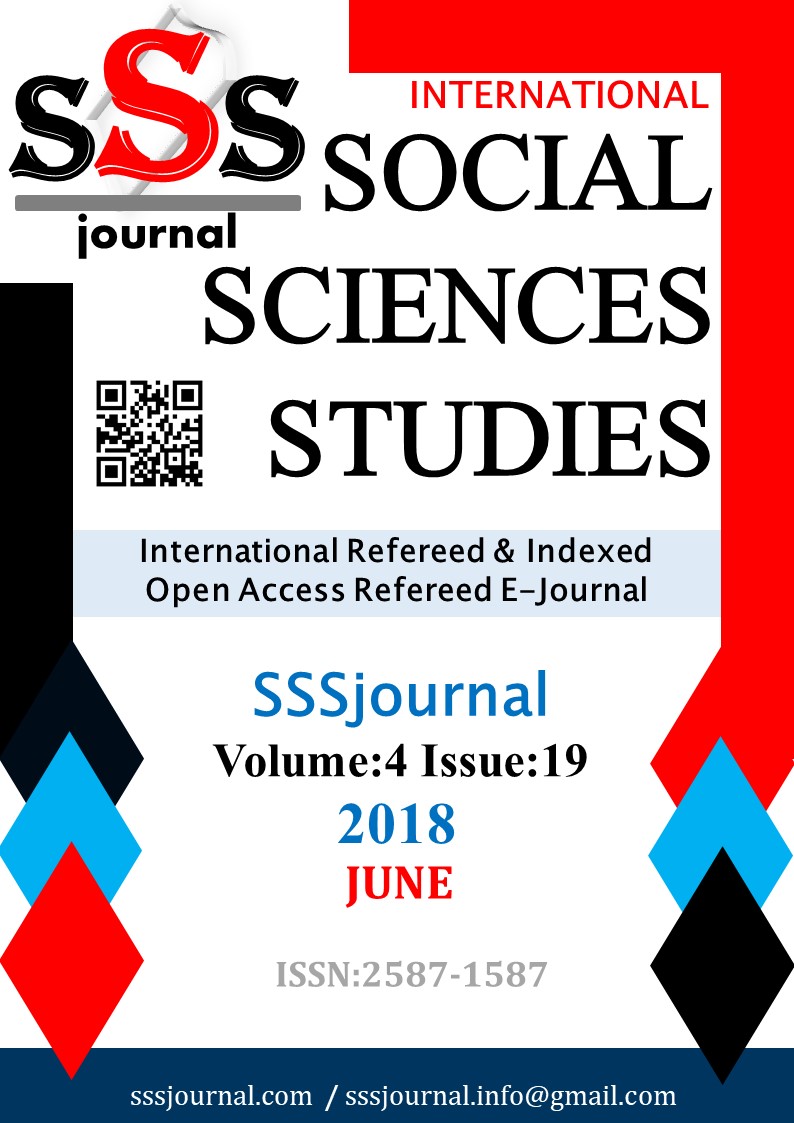EMİNE SEVGİ ÖZDAMAR’IN MUTTERZUNGE ADLI ESERİNDEKİ KALIP İFADELER VE TÜRKÇE ÇEVİRİSİNDEKİ KARŞILIKLARI
Author :
Abstract
Emine Sevgi Özdamar’ın Mutterzunge adlı eserinin dilsel analizi üzerine odaklanan çalışmamızın temel araştırma konusunu, bu eserde kullanılan atasözü, deyim ve diğer kalıp ifadelerin kaynak eserden hedef esere hangi çeviri yöntemine göre aktarıldığı oluşturmaktadır. Bu bağlamda kaynak eserde kullanılan atasözü, deyim, kalıp ifade gibi dilsel kullanımlar listelenmiş, bu kullanımların hedef esere hangi çeviri tekniğine göre aktarıldığı betimsel araştırma yöntemine göre analiz edilmiştir. Analizden elde edilen veriler ışığında, tercih edilen çeviri tekniğinin eserin anlamsal bütünlüğünü koruması açısından uygunluğu da bu çalışmada tartışılmıştır. Çalışmamızın örneklemini oluşturan Mutterzunge adlı eser Türk Göçmen Edebiyatı’nın eserlerinden biri olmasından dolayı, çalışmamızda ayrıca Göçmen Edebiyatının temel özelliklerine, kuşaklar ve temsilcilerine değinilmiştir. 103 sayfadan oluşan Mutterzunge adlı eserde toplam 180 adet deyim, atasözü ve kalıp ifade kullanımına rastlanmıştır. Bu 180 kullanımın %54,39’unun Sözcüğü Sözcüğüne Çeviri yöntemine göre hedef dile aktarılması okurda yüksek oranlı bir anlaşılmazlık durumu ortaya çıkarmaktadır. Çünkü bu çeviri yöntemine göre hedef dile aktarılan dilsel kullanımların hedef dilde karşılıkları tam anlamını yakalayamamaktadır. Bundan dolayı, edebi çevirilerde kaynak eserde yer alan dilsel ifadelerin hedef dile sözcüğü sözcüğüne değil de eşdeğer karşılıklarıyla çevrilmesi daha faydalı olacağı sonucuna ulaşılmıştır.
Keywords
Abstract
Main research topic of our study which focuses on the linguistic analysis of Emine Sevgi Özdamar work, Mutterzunge, consists of the translation method by which the proverbs, idioms and other expressions used in this work were translated to the target work. In this context, linguistic usages such as proverbs, idioms, and expressions used in the source work are listed and the method of rendition of those usages to the target work and the translation technique was analyzed according to the descriptive research method. In the light of data obtained from the analysis, the pertinence of the preferred translation method in terms of preserving the semantic integrity of the work is also discussed in this study. Since Mutterzunge is one of the major works of Turkish Immigrant Literature, which constitutes our study, we mentioned the main characteristics, the generations and the representatives of Migrant Literature in our study. As a result of this study, a total of 180 idioms, proverbs and expressions were found in Özdamar's work, Mutterzunge, consisting of 103 pages of, we established that the metaphrasing 54.39% of these 180 expressions into the target language resulted in a high level of ambiguity among the readers. Because, the meaning of those expressions which are translated to the target language according to this method, can't give the exact meaning of those used in the target equivalents. Therefore, it would be more suitable to translate linguistic expressions contained in the source work into their equivalents in the target language rather than verbatim translation.
Keywords
- Aksoy, N. B. (2002). Geçmişten Günümüze Yazın Çevirisi, İmge Kitabevi Yayınları, Ankara.
- Aksoy, N. B. (2002). Geçmişten Günümüze Yazın Çevirisi, İmge Kitabevi Yayınları, Ankara.
- Aslan, F. &Aksöz, A.S. (2002). Zur Übersetzung von kulturspezifischen Elementen bei literarischenTexten aus didaktischer und methodischer Perspektive. Ege Alman Dili ve Edebiyatı Araştırmaları Dergisi: IV. Edebi Çeviri ve Kültür Transferi Özel Sayısı, 335 – 346.
- Asutay, H. / Çelik, J. A. (2015). “Göçmen Yazını Yazarı Emine Sevgi Özdamar’ın “Mutterzunge” AdlıEserinde Dilsizlik Sorunsalına Bakış” Trakya Üniversitesi Sosyal Bilimler Dergisi Aralık, Cilt 17, sayı 2, s. 281-294.
- Balcı, U. (2017). Migrantenliteratur im DAF-Unterricht. AV Akademikerverlag, Saarbrücken.
- Ekiz, T. (2007). Avrupa Türk Edebiyatı ve bir temsilcisi: Emine Sevgi Özdamar. Çankaya Üniversitesi Fen- Edebiyat Fakültesi, Journal of Arts and Sciences Sayı: 7, s. 33-47.
- Kocadoru, Y. (1997). Zwischen Ost-Westlicher Ästhetik, Deutschsprachige Literatur von Türken. Birlik Ofset, Eskişehir.
- Kocadoru, Y. (2003). Geçmişten Günümüze Almanya’da Almanca Yazan Türkler ve Emine Sevgi Özdamar, Eskişehir: Rema Matbaacılık.
- Kocadoru, Y. (2004). "Die dritte Generation von türkischen Autoren in Deutschland – neue Wege, neueThemen," in: Die andere Deutsche Literatur, Istanbuler Vorträge, Hrsg.: Durzak, Manfred & Nilüfer Kuruyazıcı (Würzburg: Königshausen&Neumann Verlag), S.134-139.
- Kuruyazıcı, N. (1990). "Stand und Perspektiven der türkischen Migrantenliteratur unter dem Aspekt des‚Fremden‘ in der deutschsprachigen Literatur,“ in: Begegnung mit dem „Fremden“, Grenzen-Traditionen-Vergleiche. Akten des VII. internationalen Germanisten-Kongress, Tokyo 1990, Hrsg.: Iwasaki, Eijiro (München: Iudicium Verlag), S. 93-100.
- Lange, A. (1996). Migrationsliteratur-Ein Gegenstand der interkulturellen Paedagogik?, Frankfurt: IKO Verlag.
- Özdamar, E. S. ( 2002). Mutterzunge. 2.Auflage. Rotbuch Verlag, Berlin.
- Öztürk, A. O. (2001). Alamanya Türküleri; Türk Göçmen Edebiyatının Sözlü / Öncü Kolu, Ankara: Kültür Bakanlığı.
- Rösch, H. (1992). Migrationsliteratur im interkulturellen Kontext. Eine didaktische Studie zur Literatur von Aras Ören, Aysel Özakın, Franco Biondi und Rafik Schami, Frankfurt: IKO Verlag.
- Tekinay, A. (1997), "In drei Sprachen leben," in: Denn du tanzt auf einem Seil; Positionen deutschsprachigerMigrantInnenliteratur, Hrsg.: Fischer, Sabine & M. McGowan, (Tübingen: Stauffenburg Verlag), S.27-33. Yalçın, P. (2015). Çeviri Stratejileri. Kuram ve Uygulama. Ankara: Grafiker Yayınları.
- Yano, H. (2007). „Migrationsgeschichte,“ in: Interkulturelle Literatur in Deutschland. Ein Handbuch, Hrsg.: Chiellino, Carmine (Stuttgart: J.B. Metzler Verlag), S. 1-17.
- Yazıcı, M. (2007). Yazılı Çeviri Edinci. Multilingual.
- Yıldırım A. /Şimşek H. (2013). Sosyal Bilimlerde Nitel Araştırma Yöntemleri, Seçkin Yayıncılık, Ankara Zengin, D. (2016). Edebi Çevirinin Özellikleri. Tiydem Yayıncılık, Kayseri.
